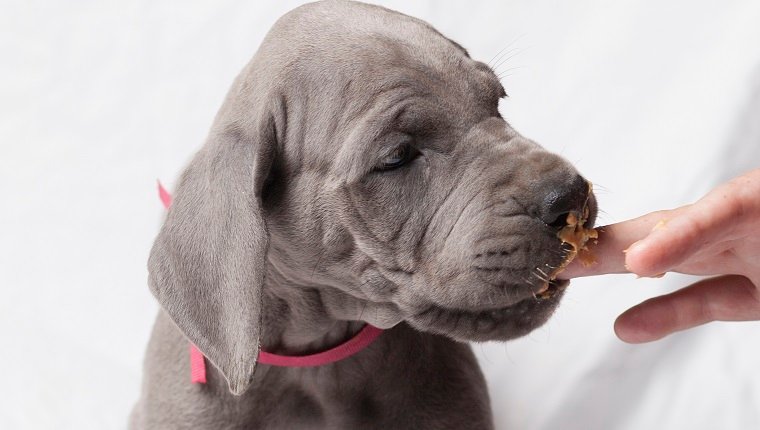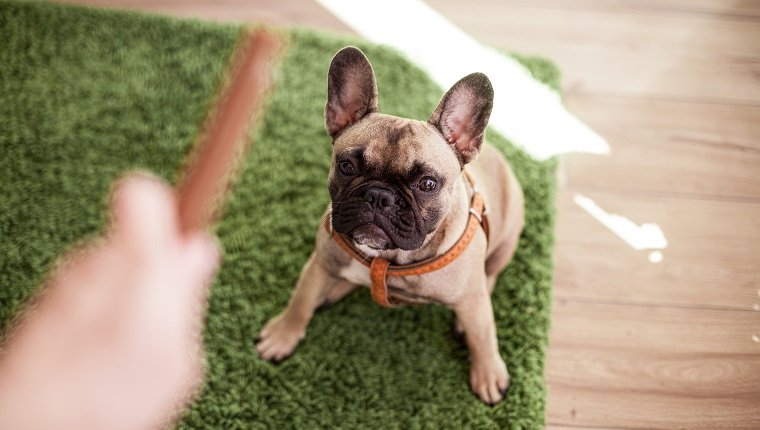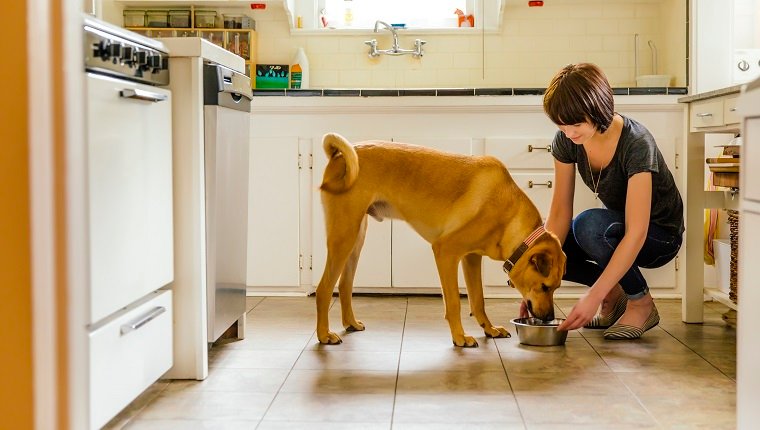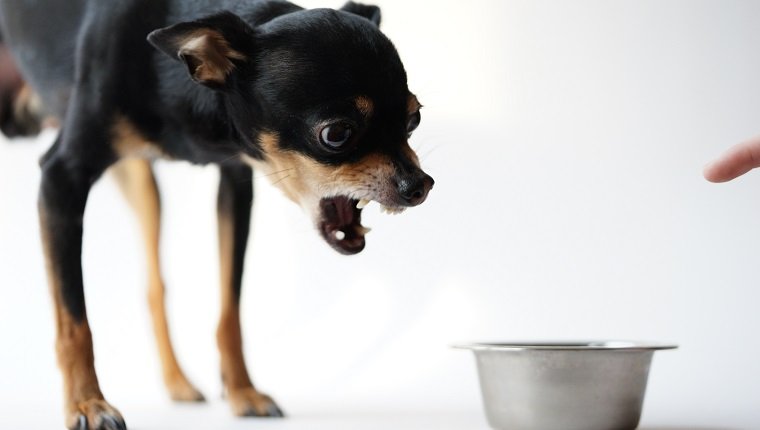Once your family’s dog food hits the bowl, who owns it? Does Rover kick you out of the kitchen at dinner? What happens if you need to take away a delicious bone or chew it?
If food, bones, or chews turn your lover into a growling, growling monster, then your dog has a resource conservation problem, or CPA – canine possession aggression. Food aggression is the most common form of CPA.
Here’s what you should know about food aggression and guarding in dogs and what you can do about it.
Does your dog eat alone or in good company?
We tend to teach our children to “leave the dog alone while they eat.” And for good reason, because most dogs don’t think much differently about small children than they do about other dogs.
However, if the adults in the household also have to tiptoe around the dog while eating, the dog may consider itself the true “owner” of the food. In the wild, dogs claim to have valuable resources and will protect food for other dogs or animals that may take their food while protecting it.
Our dogs should allow us to reach for their bowls, even if they are eating. Our pups must learn to tolerate the presence of people approaching them while eating, and also learn to tolerate bones or toys being taken away.
Early training: Practice the “give me that” exercise

Ideally, we start convincing puppies from a very young age that we are the boss and therefore the true owners of their food.
Many training books advise pet parents to “trade” by exchanging items when a puppy grabs any forbidden item. The problem is that forbidden items are often more valuable than treats for dogs.
A very useful training exercise involves teaching puppies to make us open their mouths so we can remove or add something (for example, if you need to give the dog pills). We call it the “give me that” exercise.
Start by placing a little cream cheese or peanut butter on the end of your index finger.
Walk up to your puppy and say “give me that” if they have something you don’t want them to have, you’ll use the same tone while opening your mouth and quickly putting cream on the cheese on their tongue.
Walk away calmly after that, as if you took something from them. If puppies are used to hearing “give me that” and actively add a wonderful taste to their mouths, it will become less difficult when you need to open their mouths to take something from them.
If your puppy doesn’t hate opening its mouth, it will also be easier to administer medication, brush your dog’s teeth, or have their mouth examined by a veterinarian.
After opening your mouth and giving them cream cheese or peanut butter for a week or so, start opening your mouth and rubbing your fingers on your teeth. Finally, continue to clean your teeth daily with flavored dog toothpaste and finger brushes.
Control the bowl and teach your puppy patience
Teach your dog that you have the right to food, and that they must show an urge to control at the dinner table by securing the dog’s food and leaving it on the kitchen counter.
Then sit down at the table yourself and eat any type of food – you can even eat a few cookies – eat first and then feed your dog. Dogs should sit back and wait patiently until you are done before you can put down their bowls.
If your dog is too impulsive to wait, take their crates to the kitchen and pull them to you, and put them in the crate while you eat. Before giving them dinner, get them out of the crate and sit them down before putting the bowl down.
Fill another bowl with dog food and just put a handful on their plate. When they eat, reach out and add an extra handful so they get used to your hand in or near the bowl.
Occasionally reach for the bowl while they eat, wait a few seconds, sit them down, and put it back.
Give your dog enough food at every meal so they don’t feel deprived or hungry. A hungry dog almost always has impulse control problems around food.
If your dog is overweight, your veterinarian can recommend a food to control the weight, or you can add roughage such as canned green beans or freshly grated carrots. This helps them feel fuller without consuming extra calories.
Work with dogs that already have problems

Sometimes we adopt a dog that has been controlling the food bowl and bones for years. Sometimes, dogs rescued from a puppy mill or neglected environment actually do have to fight for food.
In either case, doing the puppy exercises listed above may not be a safe option.
Realize that it’s not just about food; Instead, it’s about relationships. Your dog must learn to believe that you are a competent, capable leader who is in charge of everything, including territory and valuable resources. They must trust that you have their best interests at heart.
Work with a qualified behaviorist or experienced trainer who can help you convey leadership to your dog in a friendly but determined way. Demonstrating leadership will help your dog feel safer and more secure.
Start by picking up all the bones and toys and placing them in a basket or box out of your dog’s reach. They can only chew one thing at a time, so no more than one can be on the floor or in the crate at any one time.
If you walk into a room and see a toy or bone lying there, the dog ignores it, just pick it up and put it back in the basket. If your dog needs to play with something, ask them to come to you, sit them down, and reach for something for them.
This conveys to the dog that the toys and bones are yours and that you allow them to play with the items and not vice versa.
Apply your training to mealtimes
About their food bowls, simply start. Have your dog sit down before you put down the food. Once they can do that, stand near them while they eat, ignoring any barking or guarding performance.
After a few days, if you haven’t tried to take it away, your dog should accept your closeness to the food. Once they’ve done that, then start using your feet – please put on shoes – to push the bowl a bit while they eat.
It starts with them only doing it once at dinner, but progresses to the point where you can actually push the bowl completely away, standing between the dog and the bowl.
If you think your dog might lose his temper, tie them on a leash so you can pick up the leash and pull them away if needed.
Dogs know that leaders can keep them moving, even away from valuable objects, so using a leash, or your body blocking them, or your foot pushing are all leadership exercises. For best results, do all of these things without speaking.
Be patient and persistent, but calm and collective

Start any form of leadership exercise, including those around the food bowl, with confidence, but quiet and calm. If we shout loudly and even chatter, we are not responsible wolf pack leaders.
Remember that you are the one who provides food and toys, and you are the one responsible for ensuring that your dog does not pose a danger to anyone. Therefore, you not only have the right, but also the responsibility, to become the role of the head of the bag.
Be persistent, don’t give up. Almost every dog can accept that adults can control food, bones, and toys.
But remember that dogs treat smaller children like other dogs, putting members as equals with themselves, so don’t do any of these exercises in your child’s presence and never let your child do anything that could put them at risk.
If implementing these recommendations does not significantly improve your dog’s food aggression behavior within three weeks, then consider contacting an experienced canine behavior specialist. They can help by assessing your dog and making sure there are no other issues that need to be addressed.

